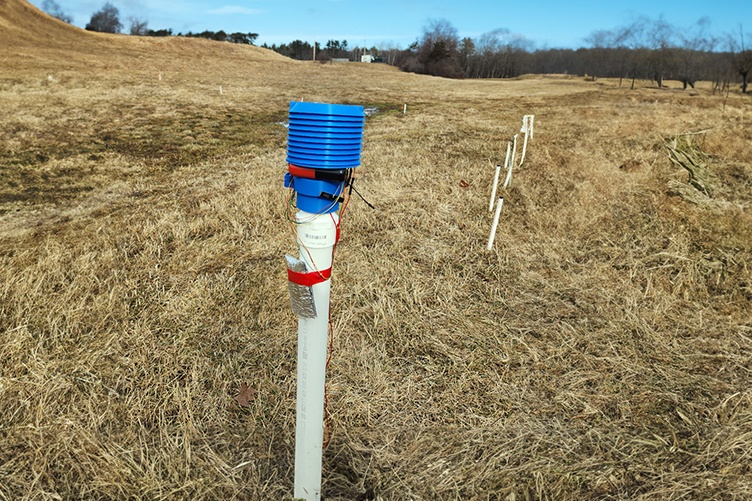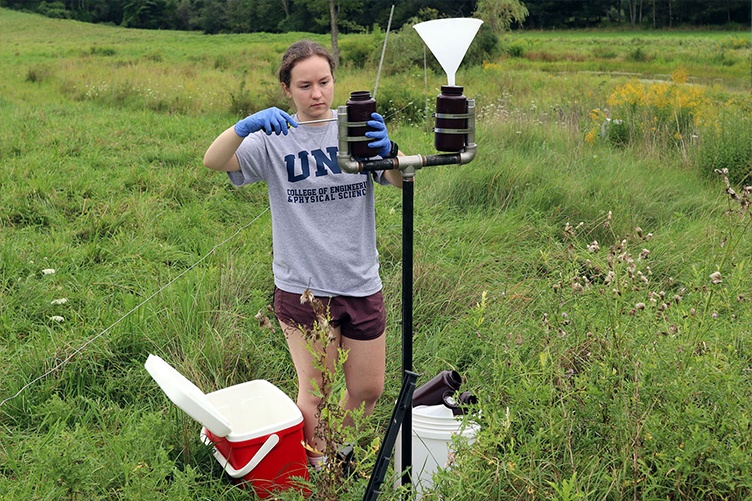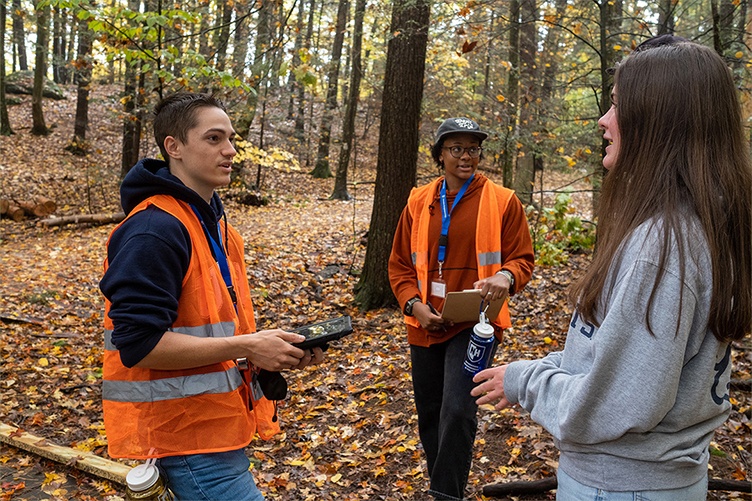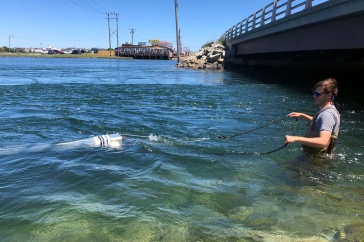Collaboration breeds innovation. That’s the impetus for the New Hampshire Agricultural Experiment Station’s Collaborative Research Enhancement Team Exploration (CREATE) program. Launched in 2022, the program was designed to spark imagination and problem-solving spanning disciplines across the University of New Hampshire, bringing together scientists—often with significantly different backgrounds—to identify and find innovative solutions to issues affecting New Hampshire and the Northeast.
“By sparking and supporting collaborations among diverse fields, such as engineering, plant science, earth science, water research and social science, we hope this program will leverage the world-class scientific brainpower across all of UNH to address today’s and tomorrow’s agriculture, food, and natural resources in New Hampshire through research and innovation—the mission of the NH Agricultural Experiment Station,” described Anton Bekkerman, NHAES director and associate dean of the UNH College of Life Sciences and Agriculture.
“We are currently seeking proposals for this year’s round of support, but it is exciting to share the collaboration and progress of projects that began in the inaugural year,” Bekkerman added.
Current CREATE Projects:
- Using oyster biosensors to improve aquaculture yield and food safety
- Developing a mobile sensor for measuring soil carbon/nitrogen levels
- Measuring the wet deposit of PFAS chemicals, also known as 'forever chemicals' in a suburban watersheds
- Exploring links between species richness/biodiversity and psychological wellbeing
- View interactive map of current CREATE projects
Using oyster biosensors to improve aquaculture yield and food safety
Research Goal
Develop and test a biosensor network that can offer real-time health and environmental information on farmed oysters to improve cultivated oyster stocks.
Research Team
College of Life Sciences and Agriculture:
- Easton White, project lead
- Brittany Jellison, project lead
- Bonnie Brown
- Andrew Villeneuve
New Hampshire’s growing oyster aquaculture industry brings significant economic benefits to the state, but farmers’ success is heavily dependent on properly choosing a site and monitoring water quality conditions at that site. A current limitation, however, is determining the suitability of a site and oyster health as environmental conditions change throughout a season and across seasons. As such, developing, testing and implementing a network of oyster-attached biosensors at farms located in New Hampshire Great Bay can significantly improve oyster farmers’ ability to succeed.
According to Easton White, an assistant professor of biological sciences at the UNH College of Life Sciences and Agriculture, oyster farmers may have little to no growth in their stock each season—or they might even see decreases in their oyster numbers due to high mortality rates. Often, this will leave producers questioning what caused the mortalities and/or diminished stock growth.
“With these sensors, farmers can see what is hidden under the surface, receiving a real-time look at changes in the activity and behavior of farmed oysters and helping them determine practices that can improve the health of their stock and the sustainability of Great Bay’s burgeoning oyster industry.” ~ Brittany Jellison, assistant professor of biological sciences, UNH College of Life Sciences and Agriculture

Marine biology summer lab interns Peyton Lockett and Julia Bolton test sensors attached to oysters.
“Oyster farmers and resource managers require real-time data to make decisions and understand what factors may be affecting their oysters,” said Easton. “With this information, farmers could increase revenue by boosting oyster growth rates or reducing mortality.”
The research is being carried out in three main phases. First, a network of biosensors is being built and tested in collaboration with a joint undergraduate engineering and biology course (TECH 797) at UNH, with co-instructors Elizabeth Fairchild, a Station scientist and a UNH research associate professor of biological sciences, and May-Win Thein, an associate professor of mechanical and ocean engineering in the UNH College of Engineering and Physical Sciences. The biosensors use high-frequency non-invasive technology—involving small high-frequency electrodes attached to the oyster valves—to monitor the distance between the tips of the upper and lower jaws, or gape distance, as a proxy for health. Data from these sensors will be transmitted and analyzed at UNH.
“As the sensor network monitors environmental data and gaping activity, it turns the aquacultured oysters into ‘oyster sentinels,’ providing farmers an alert on issues like feeding, winter torpor, water quality, hypoxia (low oxygen conditions) and thermal changes.” ~ Bonnie Brown, professor of biological sciences, UNH College of Life Sciences and Agriculture
Developing an on-the-go sensor to enable low-cost, rapid measurements of soil carbon/nitrogen levels
Research Goal
Create an in-field sensor for measuring soil carbon, nitrogen and similar nutrient to allow farmers to better determine soil health and fertilization needs.
Research Team
College of Life Sciences and Agriculture:
College of Engineering and Physical Sciences:
Soil organic matter, or SOM, which contains both carbon and nitrogen, plays a crucial role in growing crops as well as a variety of physical, chemical and biological processes and is directly linked to essential ecosystem services—like nutrient cycling and storage, pollutant absorption and retention and carbon dioxide sequestration. However, measuring soil carbon and nitrogen can often be a difficult and technical task for farmers and other growers to perform themselves. Developing and testing an on-the-go sensor in the Northeast can offer a simple, low-cost and immediate method for measuring soil health in real time, providing farmers, land managers and environmentalists a tool for making informed decisions about soil quality, nutrient requirements and carbon sequestration practices.
“Ultimately, we’ll be empowering farmers and growers with immediate and accurate data on soil health and nutrient dynamics so that they can make timely decisions in optimizing land management and implementing sustainable agricultural practices.” ~ Md Shaad Mahmud, assistant professor of electrical and computer engineering, UNH College of Engineering and Physical Sciences
Currently, soil carbon and nitrogen are measured by collecting a field sample, followed by processing and analyzing that sample in the lab. However, this is a costly and time-consuming process that requires lab expertise to run the equipment, noted Wil Wollheim, Station scientist and a professor of natural resources and the environment in the UNH College of Life Sciences and Agriculture.
“What we’re developing is a simple-to-use field instrument that provides both carbon and nitrogen estimates,” said Wollheim. “The tool will be much more cost-effective than the current method, and it’ll offer farmers the information they need in real-time versus waiting for a lab to provide that information back to them.”
Measuring wet deposit of per- and polyfluoroalkyl substances (PFAS) chemicals in a suburban watershed
Research Goal
Measure per- and polyfluoroalkyl substances (PFAS) levels in precipitation, agricultural soils and a regional watershed to better understand the concentration and deposition of these chemicals in the landscape.
Research Team
College of Life Sciences and Agriculture:
College of Engineering and Physical Sciences:
Per- and polyfluoroalkyl substances, or PFAS, are a group of chemicals known for being extremely stable at the molecular level—making them resistant to decomposition and giving them the label of ‘forever chemicals.’ PFAS are found in many industrial and consumer products, with one of the mostly widely known of these substances being Teflon. With more than 5,000 PFAS developed, and hundreds already detected in environmental samples, this chemical class has raised concerns due to their toxicity to humans and animals, as well as health effects that can include cancer, reduced fertility, liver and thyroid diseases.
The presence and persistence of PFAS in water supplies is of particular concern in New Hampshire and the broader New England region because the compounds may accumulate in ecosystems, including in grass-fed and foraging livestock, thus posing significant health and economic impacts. Measuring PFAS levels in precipitation, soils and surface waters will help to better understand how levels change through time and as a function of storm events.
“In March 2023, the EPA proposed drinking water regulations for six PFAS compounds… Understanding how and what PFAS are being deposited across the landscape through precipitation is an important piece of information for stakeholders who may be impacted by the new regulations.” ~ Paula Mouser, professor of civil and environmental engineering, UNH College of Engineering and Physical Sciences
“Most PFAS are long-lived in the environment while others partially break down into smaller PFAS that may be transported through the soil, water and air,” said Adam Wymore, Station scientist and research assistant professor of natural resources and the environment in the UNH College of Life Sciences and Agriculture. “As these chemicals accumulate in the environment, they may move up the food web into food products and livestock.”
While some of the major PFAS sources in our communities have been identified, these substances and others move around the landscape, he added.
“Our project is specifically looking at a focused list of 40 PFAS that move through the environment in precipitation and runoff,” said Wymore. “These compounds are released through other sources, then move into the atmosphere and are transported along storm tracks before being deposited here in the Northeast.”

Katherine Wieck ’23, a master’s student in the CEPS civil and environmental engineering program, collects samples gathered at a PFAS sampling site.
Katherine Wieck ’23, a master’s in civil and environmental engineering student at CEPS, assists in sample collection and data management. Upon graduating from the geology program at CEPS, she pursued research in Mouser’s lab to focus on PFAS-related research.
“By measuring PFAS concentrations across different location types—from agricultural to urban areas—we’ll also see how PFAS concentrations and profiles vary across the Great Bay watershed,” said Wieck. “It’s valuable to collect different types of samples such as precipitation, sediments, and soils as some PFAS can behave differently in different mediums, resulting in different PFAS concentrations.”
Exploring links between species richness/biodiversity and psychological wellbeing
Research Goal
Identify a link between biodiversity and recreational experiences to better inform forest management practices and recreational education resources.
Research Team
College of Life Sciences and Agriculture:
- Remington Moll, project lead
- Laura Kloepper
- Karina Sanchez
College of Health and Human Services:
- Lauren Ferguson, project lead
Hiking's popularity in the United States continues to surge, benefiting New Hampshire's recreational tourism landscape. The White Mountain National Forest attracts over six million visitors annually with its extensive network of hiking trails. And while research highlights the physical and mental health benefits of hiking, exploring how the biological diversity of the forest can further enhance these benefits.
“There’s a large body of evidence that shows humans have improved physical and mental health outcomes when they are exposed to natural environments,” described Lauren Ferguson, an assistant professor of recreation management and policy at the UNH College of Health and Human Services. “We are still trying to uncover what exactly it is about natural environments that is beneficial for human health and wellbeing?”
“Perhaps it’s the biodiversity,” she added. “The more species we see and hear could influence our experience and the ecosystem services we receive from spending time in natural spaces.”

Katharine Hamel, Abby Cote and Ridgely Ward, all from the CHHS recreation management and policy program, practice their surveying skills in UNH’s College Woods.
The study seeks to understand the connection between mood, mental well-being and the biodiversity of the surrounding environment, with a goal of investigating whether hiking on trails with greater and more diverse animal and plant life can improve psychological well-being. Beginning this summer, the research team began conducting field experiments at UNH woodland properties. In addition to measuring the biodiversity of birds, mammals and frogs at the various sites, they also surveyed visitors to gauge their perceptions of wildlife biodiversity and psychological well-being in relation to hiking and walking. The study will span all four New England seasons to assess the seasonal influence on visitors' perception of biodiversity and its impact on their well-being.
“Many animals make species-specific vocalizations, so we can identify what animals are using College Woods, even if we can’t see them. So far this summer, we have found five bat species—more than half the number of bat species known to reside in New Hampshire.” ~ Laura Kloepper, assistant professor of biological sciences, UNH College of Life Sciences and Agriculture
This material is based on work supported by the NH Agricultural Experiment Station through joint funding from the USDA National Institute of Food and Agriculture (under Hatch award numbers 7004018, 7004025, 7004133 and 7004037) and the state of New Hampshire.
-
Written By:
Nicholas Gosling '06 | COLSA/NH Agricultural Experiment Station | nicholas.gosling@unh.edu






















































